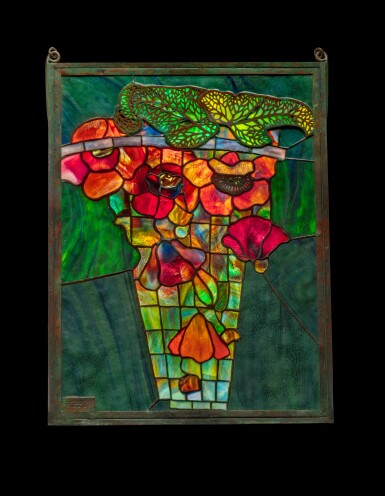The Doros Collection: The Art Glass of Louis Comfort Tiffany
The Doros Collection: The Art Glass of Louis Comfort Tiffany

Tiffany Studios
"Poppy" Lamp Shade Sample Panel
Auction Closed
December 8, 12:14 AM GMT
Estimate
25,000 - 35,000 USD
Lot Details
Description
Tiffany Studios
"Poppy" Lamp Shade Sample Panel
circa 1915
leaded glass
with tag impressed POPPY
17¼ x 13 inches (43.8 x 33 cm)
Ingenuity Beyond the Studio –
Tiffany’s Business Acumen
Louis C. Tiffany’s creative talents have been widely recognized, but his marketing genius is often overlooked. He was a phenomenal promoter of his paintings at the beginning of his artistic career, and he made certain the work of the interior decorating firm he founded in the early 1880s was widely publicized. The various and numerous marketing campaigns he later developed for his Favrile glass far surpassed even those efforts.
The advertising approaches were almost as diverse as the glass objects themselves. Almost from the very beginning, Louis C. Tiffany’s name was directly and constantly linked to the production: An 1894 advertisement mentioned “a special display of Favrile Glassware, blown under the personal supervision of Mr. Louis C. Tiffany.” Another the following year asserted “Tiffany Favrile glass is the outcome of a series of experiments recently conducted by Mr. Louis C. Tiffany.” Both claims were highly exaggerated, if not outright misrepresentations of the facts, but Tiffany was an internationally famous artist and decorator and the company highlighted his supposed role in the glass production at every opportunity.
Another favorite marketing strategy was to frequently remark that blown Favrile glass was in the permanent collection of some of the world’s leading public institutions. What was left unsaid was how the objects found their way into the museums, especially those in the United States, as Louis C. Tiffany cleverly played an active and significant role in the process. His father, Charles, brokered a deal with the Smithsonian Institution in 1896 for the museum to purchase 40 pieces at reduced prices, and a few additional vases offered as donations. That same year, H.O. Havemeyer, an early collector of Favrile glass, donated a large group of vases to the Metropolitan Museum of Art. It is highly probable that Louis persuaded Havemeyer to make the donation, a fact that was never publicly mentioned. It was all part of Tiffany’s goal to convince the American elite that his glass pieces were truly works of art that were museum-worthy.
The marketing to individual collectors who visited the Tiffany showrooms on Madison Avenue was also substantial, as the following sample panels (lots 255 and 257-258) superbly indicate. Tiffany Studios had a huge inventory of lamps and not all the models could be displayed in the limited display space. The company did offer promotional catalogs with photographs of the lamps, but the images were only in black and white and failed to establish the shade’s full impact. The solution was to make sample panels such as these three examples so that prospective customers would have a considerably better concept of what a lamp shade would look like if it was not actually in the showroom. The company also offered lamp bases, as well as desk sets, in a wide variety of patinas. Small samples, such as those offered as lot 256, were the perfect solution to present some of the available options.
- PD
